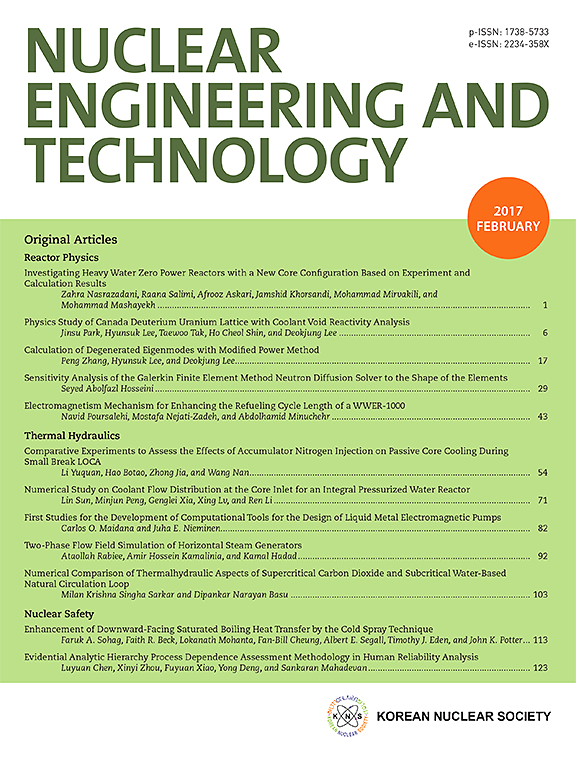Dose coefficients for the ICRP pediatric mesh-type reference computational phantoms under idealized external photon exposure geometries
IF 2.6
3区 工程技术
Q1 NUCLEAR SCIENCE & TECHNOLOGY
引用次数: 0
Abstract
The International Commission on Radiological Protection (ICRP) recently released the pediatric mesh-type reference computational phantoms (MRCPs) through ICRP Publication 156 to overcome the limitations of the pediatric voxel-type reference computational phantoms (VRCPs) of ICRP Publication 143. In the present study, these pediatric MRCPs were implemented into the Geant4 Monte Carlo code to produce a comprehensive dataset of dose coefficients for idealized external photon exposure geometries. This dataset includes 29 individual organ/tissue dose coefficients and effective dose coefficients, covering six irradiation geometries (i.e., AP, PA, LLAT, RLAT, ROT, and ISO) and 55 monoenergetic photon energies ranging from 10 keV to 10 GeV. The dataset comparison with the adult MRCPs of ICRP Publication 145 revealed substantial differences in effective dose coefficients throughout most energy ranges, primarily due to the age-related variations in organ/tissue depths, the differences reaching up to a factor ∼9. In addition, the comparisons with the pediatric VRCPs identified notable differences in effective dose coefficients, reaching up to a factor ∼4, for photon energies below 50 keV, due to the differences in phantom geometries and updates in simulation setups. For photon energies above 50 keV, deviations in effective dose coefficients between the pediatric MRCPs and VRCPs remained within 10 %.
理想外部光子暴露几何下ICRP儿科网格型参考计算幻影的剂量系数
国际放射防护委员会(ICRP)最近通过ICRP第156号出版物发布了儿童网格型参考计算幻影(MRCPs),以克服ICRP第143号出版物中儿童体素型参考计算幻影(VRCPs)的局限性。在本研究中,这些儿科mrcp被实现到Geant4蒙特卡罗代码中,以产生一个全面的剂量系数数据集,用于理想的外部光子暴露几何形状。该数据集包括29个单独的器官/组织剂量系数和有效剂量系数,涵盖6种辐照几何形状(即AP, PA, LLAT, RLAT, ROT和ISO)和55个单能光子能量,范围从10 keV到10 GeV。与ICRP出版物145的成人MRCPs的数据集比较显示,在大多数能量范围内,有效剂量系数存在实质性差异,主要是由于器官/组织深度的年龄相关变化,差异可达1 ~ 9倍。此外,与儿科vrcp的比较发现了有效剂量系数的显着差异,对于光子能量低于50 keV,由于幻影几何形状的差异和模拟设置的更新,有效剂量系数达到了因子~ 4。对于50 keV以上的光子能量,儿童MRCPs和VRCPs之间的有效剂量系数偏差保持在10%以内。
本文章由计算机程序翻译,如有差异,请以英文原文为准。
求助全文
约1分钟内获得全文
求助全文
来源期刊

Nuclear Engineering and Technology
工程技术-核科学技术
CiteScore
4.80
自引率
7.40%
发文量
431
审稿时长
3.5 months
期刊介绍:
Nuclear Engineering and Technology (NET), an international journal of the Korean Nuclear Society (KNS), publishes peer-reviewed papers on original research, ideas and developments in all areas of the field of nuclear science and technology. NET bimonthly publishes original articles, reviews, and technical notes. The journal is listed in the Science Citation Index Expanded (SCIE) of Thomson Reuters.
NET covers all fields for peaceful utilization of nuclear energy and radiation as follows:
1) Reactor Physics
2) Thermal Hydraulics
3) Nuclear Safety
4) Nuclear I&C
5) Nuclear Physics, Fusion, and Laser Technology
6) Nuclear Fuel Cycle and Radioactive Waste Management
7) Nuclear Fuel and Reactor Materials
8) Radiation Application
9) Radiation Protection
10) Nuclear Structural Analysis and Plant Management & Maintenance
11) Nuclear Policy, Economics, and Human Resource Development
 求助内容:
求助内容: 应助结果提醒方式:
应助结果提醒方式:


